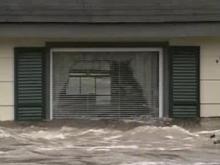- U.S.-based aid groups rush to get supplies into storm-battered Jamaica after Hurricane Melissa
- Travelers stuck in Jamaica due to Hurricane Mellissa forced to pay for unwanted extended stay
- Raleigh police officer awaits word from family in Jamaica after Hurricane Melissa devastation
- North Carolina’s leaders give insight on the effects of Hurricane Melissa
- ‘We want some answers;’ Whiteville residents demand city response to prevent flooding
20 years after Hurricane Floyd, little has changed and flooding is still a threat

Hurricane Floyd was an environmental horror story.
Doug Rader, chief oceans scientist for the Environmental Defense Fund, remembers “coffins floating, dead animals floating and coming up for many months after the storm.”
An entire year’s worth of pollution was released in a single storm – chemicals, hog waste, human waste from septic tanks and city sewer systems.
“A veritable flood of pollution, a witch’s brew of every kind of pollution you can imagine into the most precious of NC’s coastal waters,” Rader said.
Experts like him had long thought, Rader said, “The solution to pollution is dilution.”
But that changed after Floyd.
“The concentrations of pesticides and other toxicants were surprisingly high,” he said, especially in estuaries like Pamlico Sound, a crucial nursery ground for fish.
“The toxicants that are in it are just waiting to be absorbed into worms and clams that are eaten by fish that are eaten by people,” Rader said.
But the lessons of Floyd were short-lived.
“Generally, if you look at the entire landscape, we are nearly as vulnerable today as we were in 1999,” Rader said.
Despite some buyouts by the state, eastern North Carolina still has hog farms in flood plains.
“In many ways, the swine industry in North Carolina remains a disaster yet to happen again,” he said.
And people continue to live and build in places that will surely flood again.
“The future will be wetter,” Rader said. “The future will have more intense storms. So we need to get to work.”
That means factoring climate change into every public infrastructure and environmental plan.
Hurricane Floyd quick facts
- Hurricane Floyd made landfall near the Cape Fear at 2:30 a.m. on Sept. 16, 1999. At the time of landfall, Floyd was a Category 2 hurricane with maximum winds of 104 mph.
- At its peak, Floyd had maximum sustained winds of 156 mph. Sustained winds of 96 mph, with gusts up to 122 mph, were measured near Topsail Beach around 3 a.m. on Sept. 16.
- Floyd caused 56 deaths in the United States and on Grand Bahama Island. The storms was deadliest hurricane in the U.S. since Agnes in 1972.
- North Carolina had 36 people killed, $3 billion in damage, 7,000 homes destroyed, 56,000 homes damaged, 1,500 people rescued from flood areas, and power outages affecting more than 500,000 customers.
- Flood waters covered 4.2 million acres throughout the eastern U.S. Overall damage estimates range from $4.5 billion to $6 billion.
- Most deaths occurred from drowning in fresh water. Many people drowned in or near vehicles caught in flood waters.
- Floyd dumped 12 to 20 inches of rain on North Carolina. It followed on the heels of Hurricane Dennis, which had dumped 6 to 16 inches of rain.
- At Wilmington, 19.06 inches of rain fell. Setting a new record, 15.06 inches fell in one 24-hour period.
- Nine record floods occurred on rivers in North Carolina. Hardest-hit were the Tar and Neuse River basins.
- A greater than 500-year flood occurred at Rocky Mount, Tarboro and Enfield. Large portions of Rocky Mount were underwater, and the town of Princeville was covered. Wilson was also inudated.
- A total of 532 flash flood warnings were issued from northest South Carolina through New England during the storm.
- At least 16 tornadoes were spotted or confirmed throughout eastern North Carolina, including 10 in the Morehead City are and four in the Wilmington area. Confirmed tornadoes landed in Bertie and Perquimans County, destroying two houses and damaging three or four others.